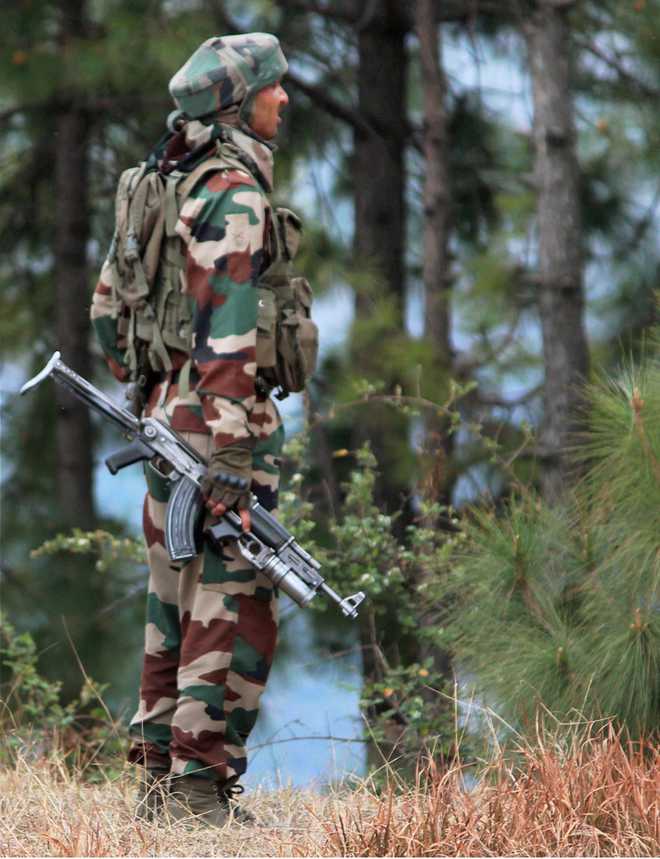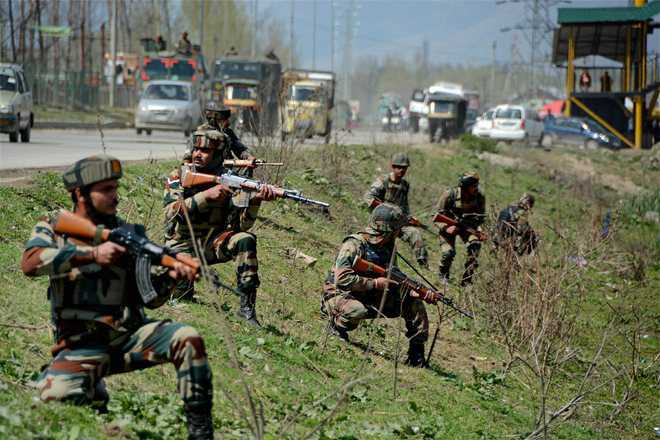
An Indian army soldier patrols near the Line of Control in Poonch district after a ceasefire violation by Pakistan on Monday. PTI
Jammu/New Delhi, May 1The Indian Army-BSF patrol, whose two members were beheaded by Pakistani special forces on Monday, might just have walked into a death trap laid by the enemy, official sources said.The incident in Krishna Ghati sector along the Line of Control in Jammu and Kashmir occurred when a joint team of the army and BSF had gone to check the veracity of an intelligence report that landmines had been planted by Pakistani troops on the Indian side.
(Follow The Tribune on Facebook; and Twitter @thetribunechd)
As they were looking for landmines, the patrol was taken by surprise by Pakistan’s Border Action Team (BAT) which had laid an ambush over 250 metre deep inside the Indian territory.While the Pakistani troops attacked two forward posts with rockets and mortar bombs, the BAT personnel lay in wait for their targets. The Indian army patrol, too, came under fusillade of gunfire, resulting in the death of two soldiers.The BAT personnel quickly moved in and beheaded two fallen soldiers, official sources said in New Delhi.It was still not known if landmines had indeed been planted in the area.K K Sharma, the Director General of BSF, one of whose personnel was killed in the attack and decapitated, met Union home secretary Rajiv Mehrishi and briefed him on the incident.”It was a pre-planned operation by Pakistan army. They had pushed in the Border Action Team over 250 metre deep inside Indian territory and set up the ambush for a long period to carry out the attack,” a senior officer said in Jammu.”Their target was a patrol party of 7-8 members, which had come out of a post,” the officer said, adding that as the posts were engaged, the patrol team members ran for cover.Two troopers — one of the army and another of BSF — were targeted by the BAT.Head Constable Prem Sagar of 200th Battalion of the BSF and Naib Subedar Paramjeet Singh of 22 Sikh Regiment of the army were killed and their bodies mutilated.The BAT is specifically employed for trans-LoC action.In Pakistan, the SSG (special services group) forms the core of BAT. Its primary task is to dominate the LoC by carrying out disruptive actions in the form of surreptitious raids.BAT attacks in the pastThere have been several BAT attacks in the past in which jawans have been beheaded or their bodies mutilated.On October 28, 2016, militants attacked a post and killed an Indian army soldier and mutilated his body close to the Line of Control (LoC) in the Machil sector.In January 2013, Lance Naik Hemraj was killed and his body mutilated by BAT. It also beheaded Lance Naik Sudhakar Singh. Constable Rajinder Singh of the BSF suffered injuries in the attack.In June 2008, a soldier of the 2/8 Gorkha Rifles lost his way and was captured by BAT in Kel sector. His body was found beheaded after a few days.During the 1999 Kargil conflict, Captain Saurabh Kalia was tortured by his Pakistani captors who later handed over his mutilated body to India. In February, 2000, terrorist Ilyas Kashmiri had led a raid on the Indian army’s ‘Ashok Listening Post’ in the Nowshera sector and killed seven Indian soldiers.Even then, Kashmiri had taken back to Pakistan the head of a 24-year-old Indian jawan Bhausaheb Maruti Talekar of the 17 Maratha Light Infantry. — PTI






















































































































